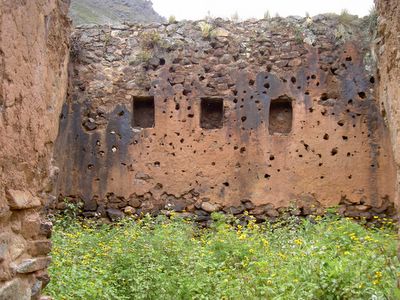Diane: After several days of bus rides and primarily short city walks, I thought we should start getting in shape for Machu Picchu. The Machu Picchu site spans an altitude difference of 1000 meters!
And so we set off to Pumamarca, walking up a gently sloping river valley. We passed many stone terraces, generally of inferior construction to those we saw yesterday in Ollantaytambo, but just as big. Each terrace was taller than me (click below and blow up the photo to see just how small I am).
They don't appear to be cultivating anything on these terraces.
Part of our hike took us alongside a stone irrigation channel that had been maintained for centuries. Even so, the land on either side consisted of overgrown grasses and bushes.
I thought the terraces might make good grazing spots, but we saw no cows or sheep happily munching away. The stone steps that led from one terrace to the next were nothing more than large stone rungs sticking out from the terrace walls. Climbing these large steps was exhilarating. They were still functional after who knows how many centuries of disuse.
The mountain views were spectacular. Although the valleys of this region were part of the breadbasket during Incan times providing food for 100,000 or more, the surrounding mountains were harsh.
Pumamarca is, for the most part, a pre-Incan site, constructed over several centuries, revealing varying construction techniques. Tourists don't come here, because they are too intent on getting to Machu Picchu. Even those who stay in nearby Ollantaytambo for a couple of days don't bother with the 22km round trip hike. As a result, many of the rooms were smothered in wildflowers.

As soon as we arrived, everybody else lay down for a nap, either in the sun or in their own hat-created shade.
Linguistic Aside: For those of you who, like me, enjoy teasing out the common roots in words, take a look at the word "sombrero". It means "hat" in Spanish and when I think of a sombrero, an image of a farmer working in the fields with a broad brimmed straw hat comes to mind. There are other Spanish words for different types of hats, such as bonnets or warm winter knit hats. But sombrero has the same root as the word for shadow or shade, "sombra". So if looking at the roots of the word "sombrero", you might literally translate "hat" as a "maker of shade". And so, in Spanish, the phrase "hat-created shade" might be a bit redundant.
In any event, since we were the only ones there and the sun was shining, we had found a perfect resting spot. Lunch would have to wait.



TM climbed way up above the Pumamarca ruins to capture a bird's eye view of this walled enclave.
My favorite building looked like a face, with two eyes, a nose and bushy eyebrows.

No comments:
Post a Comment